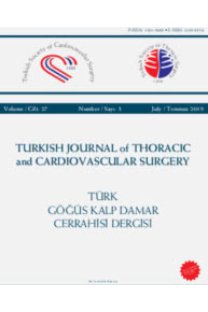Toraks deformitelerinde kaburga kemiği uzunluğunun kostal kıkırdak uzunluğuna oranı ile deformite şiddetinin belirlenmesi
Determination of severity of deformity with rib length to costal cartilage length ratio in thorax deformities
___
- 25. Gocmen H, Doganay S, Akkas Y, Eken OA, Guler N. The relationship of the indexes used in the classification of pectus excavatum with spirometric and demographic parameters. Firat Med J 2015;20:156-60.
- 24. Fagelman KM, Methratta S, Cilley RE, Wilson MZ, Hollenbeak CS. The Depression Index: an objective measure of the severity of pectus excavatum based on vertebral diameter, a morphometric correlate to patient size. J Pediatr Surg 2015;50:1130-3.
- 23. Park CH, Kim TH, Haam SJ, Lee S. Asymmetric Pectus Excavatum Is Associated with Overgrowth of Ribs Rather Than Cartilage. Thorac Cardiovasc Surg 2015;63:427-32.
- 22. Park CH, Kim TH, Haam SJ, Lee S. Does overgrowth of costal cartilage cause pectus carinatum? A three-dimensional computed tomography evaluation of rib length and costal cartilage length in patients with asymmetric pectus carinatum. Interact Cardiovasc Thorac Surg 2013;17:757-63.
- 21. David VL, Cerbu S, Haragus H, Popoiu MC, Stanciulescu CM, Cozma G, et al. Costal Cartilages Do Not Overgrow in Patients with Pectus Excavatum. Med Princ Pract 2016;25:533 -8.
- 20. Nakaoka T, Uemura S, Yoshida T, Tanimoto T, Miyake H. Overgrowth of costal cartilage is not the etiology of pectus excavatum. J Pediatr Surg 2010;45:2015-8.
- 19. Nakaoka T, Uemura S, Yano T, Nakagawa Y, Tanimoto T, Suehiro S. Does overgrowth of costal cartilage cause pectus excavatum? A study on the lengths of ribs and costal cartilages in asymmetric patients. J Pediatr Surg 2009;44:1333-6.
- 18. Shamberger CR. Chest wall deformities. In: Shields TW, editor. General Thoracic Surgery. Philadelphia: Williams-Wilkins; 1994. p. 529-55.
- 17. Kowalewski J, Brocki M, Zolynski K. Long-term observation in 68 patients operated on for pectus excavatum: surgical repair of funnel chest. Ann Thorac Surg 1999;67:821-4.
- 16. Brochhausen C, Turial S, Müller FK, Schmitt VH, Coerdt W, Wihlm JM, et al. Pectus excavatum: history, hypotheses and treatment options. Interact Cardiovasc Thorac Surg 2012;14:801-6.
- 15. Dean C, Etienne D, Hindson D, Matusz P, Tubbs RS, Loukas M. Pectus excavatum (funnel chest): a historical and current prospective. Surg Radiol Anat 2012;34:573-9.
- 14. St Peter SD, Juang D, Garey CL, Laituri CA, Ostlie DJ, Sharp RJ, et al. A novel measure for pectus excavatum: the correction index. J Pediatr Surg 2011;46:2270-3.
- 13. Aksakoglu G. Research techniques and analysis methods in health. İzmir: Printing House of Dokuz Eylul University Rectorate; 2001.
- 12. Park CH, Kim TH, Haam SJ, Lee S. Rib overgrowth may be a contributing factor for pectus excavatum: Evaluation of prepubertal patients younger than 10 years old. J Pediatr Surg 2015;50:1945-8.
- 11. Poston PM, Patel SS, Rajput M, Rossi NO, Ghanamah MS, Davis JE, et al. The correction index: setting the standard for recommending operative repair of pectus excavatum. Ann Thorac Surg 2014;97:1176 -9.
- 10. Chu ZG, Yu JQ, Yang ZG, Peng LQ, Bai HL, Li XM. Correlation between sternal depression and cardiac rotation in pectus excavatum: Evaluation with helical CT. AJR Am J Roentgenol 2010;195:76-80.
- 9. Mortellaro VE, Iqbal CW, Fike FB, Sharp SW, Ostlie DJ, Snyder CL, et al. The predictive value of Haller index in patients undergoing pectus bar repair for pectus excavatum. J Surg Res 2011;170:104-6.
- 8. Haller JA Jr, Kramer SS, Lietman SA. Use of CT scans in selection of patients for pectus excavatum surgery: a preliminary report. J Pediatr Surg 1987;22:904-6.
- 7. Mansour KA, Thourani VH, Odessey EA, Durham MM, Miller JI Jr, Miller DL. Thirty-year experience with repair of pectus deformities in adults. Ann Thorac Surg 2003;76:391-5.
- 6. Onen A, Sanli A, Eyuboglu GM, Gokcen KB, Karacam V. Early postoperative satisfaction report of patients with pectus excavatum corrected with minimally invasive technique. Turk Gogus Kalp Dama 2008;16:113-7.
- 5. Krasopoulos G, Dusmet M, Ladas G, Goldstraw P. Nuss procedure improves the quality of life in young male adults with pectus excavatum deformity. Eur J Cardiothorac Surg 2006;29:1-5.
- 4. Molik KA, Engum SA, Rescorla FJ, West KW, Scherer LR, Grosfeld JL. Pectus excavatum repair: experience with standard and minimal invasive techniques. J Pediatr Surg 2001;36:324-8.
- 3. Williams AM, Crabbe DC. Pectus deformities of the anterior chest wall. Paediatr Respir Rev 2003;4:237-42.
- 2. Kuhn MA, Nuss D. Pectus deformities. In Mattei P; ed. Fundamentals of pediatric surgery. New York: Springer;. 2011:313-22.
- 1. Waters P, Welch K, Micheli LJ, Shamberger R, Hall JE. Scoliosis in children with pectus excavatum and pectus carinatum. J Pediatr Orthop 1989;9:551-6.
- ISSN: 1301-5680
- Yayın Aralığı: 4
- Başlangıç: 1991
- Yayıncı: Bayçınar Tıbbi Yayıncılık
Hasan ERSÖZ, Aydın ŞANLI, Volkan KARAÇAM, İsmail AĞABABAOĞLU, Ali KARAKILIÇ, Fatma İlknur ULUGÜN
Göğüs tomografisi ile değerlendirilen metastatik akciğer tümörleri için açık cerrahi gerekli midir?
Arif Osman TOKAT, Sezgin KARASU, Hüseyin ÇAKMAK
İki taraflı akciğerde nadir bir tümör metastazı: Epiteloid trofoblastik tumor
Tevfik İlker AKÇAM, Ayşe Gül ERGÖNÜL, Önder KAVURMACI, Seda AKGÜN KAVURMACI
Rivaroksaban tedavisinin olumsuz bir etkisi olarak spontan hemotoraks
Hyang Rae LEE, Yi Yeong JEONG, Jong Deog LEE, Seung Jun LEE
Hasan KARABULUT, Eyüp Murat ÖKTEN, Cem ARITÜRK, Özcan ERDEMLİ, Fatih BAYRAK
Akın İZGİ, Çetin GEÇMEN, Muzaffer KAHYAOĞLU
Orta derece dilate çıkan aortun wrapping ile cerrahi tedavisi
Necip BECİT, Münacettin CEVİZ, Hikmet KOÇAK, Uğur KAYA, Abdurrahim ÇOLAK
Periferik arter hastalıklarında endovasküler ve hibrid tedavi deneyimlerimiz
Ahmet Turan YILMAZ, Murat UĞUR, Veysel TEMİZKAN, Ejder KARDEŞOĞLU, Murat Fatih CAN, Alper UÇAK, İbrahim ALP, Arif SELÇUK
İlginç bir mediastinal kist olgusu: Benign kistik mezotelyoma
Fazlı YANIK, Yekta Altemur KARAMUSTAFAOĞLU, Yener YÖRÜK, Fulya ÖZPUYAN
Konjenital kalp cerrahisi sonuçlarının analizi: Dört risk skorlama sisteminin karşılaştırılması
Alper GÜZELTAŞ, Sertaç HAYDİN, Behzat TÜZÜN, Hüsnü FIRAT ALTIN, Taner KASAR, Erkut ÖZTÜRK, İsmihan Selen ONAN, Okan YILDIZ
